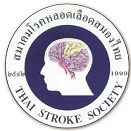Atrial Fibrillation: Cardiologist perspective
Keywords:
atrial fibrillation, anticoagulantAbstract
Atrial Fibrillation (AF) is common arrhythmia. AF associated with higher morbidity and mortality, congestive heart failure, embolic phenomenon, and ischemic stroke. The mechanism of AF is either structural abnormalities of atrium or electrical abnormalities of atrium. Atrial Fibrillation was classified into paroxysmal, persistent, long stranding persistent and permanent atrial fibrillation. Management of atrial fibrillation divided to 1. investigation and treatment of structural abnormalities and comorbid diseases 2. prevention of thrombus embolization 3. rate versus rhythm control strategies which depended on patient’s age, comorbid diseases and symptoms.
References
American Heart Association Statistics Committee and Stroke Statistics Subcommittee. Circulation. 2009;119(3):e21-181.
Kiatchoosakun S, Pachirat O, Chirawatkul A, Choprapawan C, Tatsanavivat P. Prevalence of cardiac arrhythmias in Thai community. J Med Assoc
Thai. 1999;82(7):727-33.
Lloyd-Jones DM, Wang TJ, Leip EP, Larson MG, Levy D, Vasan RS, et al. Lifetime risk for development of atrial fibrillation: the Framingham Heart Study. Circulation. 2004;110(9):1042-6.
January CT, Wann LS, Alpert JS, Calkins H, Cleveland JC, Jr., Cigarroa JE, et al. 2014 AHA/ACC/HRS Guideline for the Management of Patients With Atrial Fibrillation: A Report of the American College of Cardiology/American Heart Association Task Force on Practice Guidelines and the Heart Rhythm
Society. J Am Coll Cardiol. 2014.
Zoni-Berisso M, Lercari F, Carazza T, Domenicucci S. Epidemiology of atrial fibrillation: European perspective. Clin Epidemiol. 2014;6:213-20.
6. Camm AJ, Lip GY, De Caterina R, Savelieva I, Atar D, Hohnloser SH, et al. 2012 focused update of the ESC Guidelines for the management of atrial fibrillation: an update of the 2010 ESC Guidelines for the management of atrial fibrillation. Developed with the special contribution of the European Heart Rhythm Association. Eur Heart J. 2012;33(21):2719-47.
Savelieva I, Camm AJ. Practical considerations for using novel oral anticoagulants in patients with atrial fibrillation. Clin Cardiol. 2014;37(1):32-47.
Wyse DG, Waldo AL, DiMarco JP, Domanski MJ, Rosenberg Y, Schron EB, et al. A comparison of rate control and rhythm control in patients with atrial
fibrillation. N Engl J Med. 2002;347(23):1825-33.
Corley SD, Epstein AE, DiMarco JP, Domanski MJ, Geller N, Greene HL, et al. Relationships between sinus rhythm, treatment, and survival in the Atrial
Van Gelder IC, Groenveld HF, Crijns HJ, Tuininga YS, Tijssen JG, Alings AM, et al. Lenient versus strict rate control in patients with atrial fibrillation. N Engl
J Med. 2010;362(15):1363-73.
Kober L, Torp-Pedersen C, McMurray JJ, Gotzsche O, Levy S, Crijns H, et al. Increased mortality after dronedarone therapy for severe heart failure. N Engl
J Med. 2008;358(25):2678-87.
Downloads
Published
How to Cite
Issue
Section
License
ข้อความภายในบทความที่ตีพิมพ์ในวารสารสมาคมโรคหลอดเลือดสมองไทยเล่มนี้ ตลอดจนความรับผิดชอบด้านเนื้อหาและการตรวจร่างบทความเป็นของผู้นิพนธ์ ไม่เกี่ยวข้องกับกองบรรณาธิการแต่อย่างใด การนำเนื้อหา ข้อความหรือข้อคิดเห็นของบทความไปเผยแพร่ ต้องได้รับอนุญาตจากกองบรรณาธิการอย่างเป็นลายลักษณ์อักษร ผลงานที่ได้รับการตีพิมพ์ในวารสารเล่มนี้ถือเป็นลิขสิทธิ์ของวารสาร





